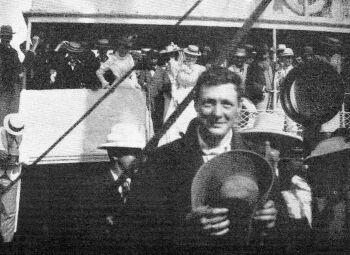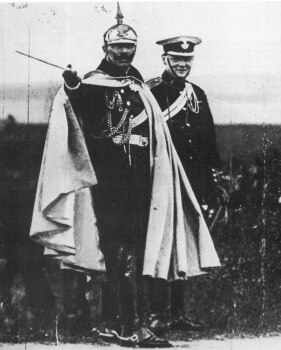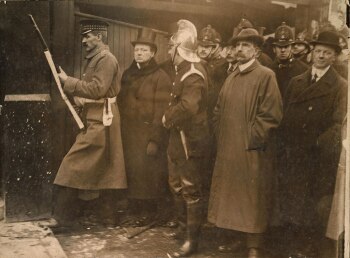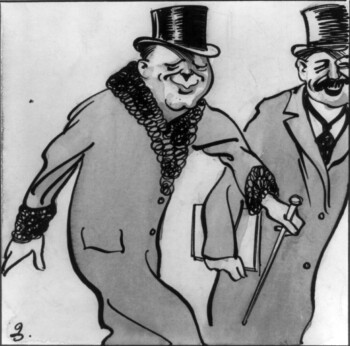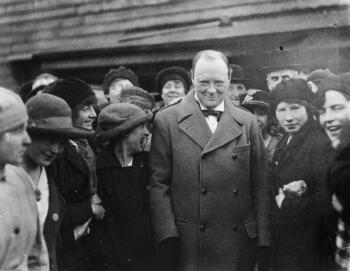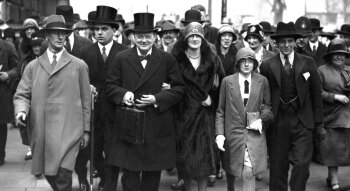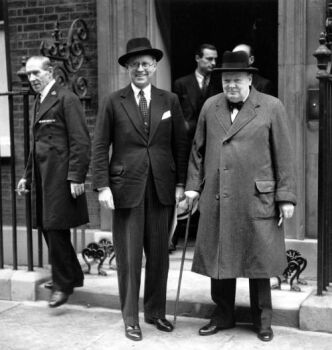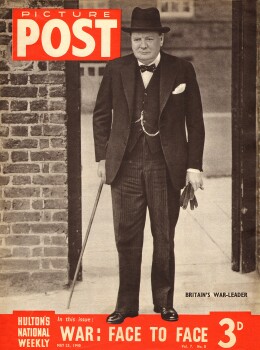O n May 10, 1940 – one of the most significant days in modern history – Winston Churchill became Prime Minister of Great Britain. Germany had just invaded France and Britain would soon stand alone.
From his first day in charge, ever onwards, Churchill’s wisdom, wit, bravery and profoundly humane spirit guided the English people, and the world, through World War II to victory.
Today, Sir Winston Churchill is remembered as one of the greatest leaders and politicians to ever lead a nation. His clear-headedness in the face of catastrophe, his resolution to inspire by appealing to the very best in those around him, remains an object lesson in leadership.
It has been exactly 80 years since Churchill took charge as Prime Minister. Sotheby’s is pleased to partner with Chartwell Booksellers in presenting a dazzling collection of rare books and manuscripts that embraces the entirety of Churchill’s long life and career. Join us as we celebrate this great occasion.
All works in this sale come to Sotheby’s from Chartwell Booksellers, the only standing bookshop in the world devoted to the writings of Winston Churchill. Named for Churchill’s beloved home in England’s Kent countryside, Chartwell is now in its 37th year as an independent bookstore in the heart of midtown-Manhattan, enduring home to the world's finest selection of rare Churchilliana; from first editions and books about Winston Churchill to precious autograph letters, photographs and documents.
Auction Highlights
[Winston Churchill] — Yousuf Karsh, photographer
Vintage silver gelatin print, signed by Karsh, 1941 [printed ca. 1951]
Estimate $20,000 – 26,000
YOUSUF KARSH'S ICONIC PORTRAIT OF A SCOWLING WINSTON CHURCHILL (“THE ANGRY LION”)
The image was taken 30 December 1941 in an ante-room of the Ottawa House of Commons following Churchill’s address to the Canadian Parliament. The print is signed by Karsh with a white stylus on the lower right corner of the image: “J Karsh of Ottawa.” This iconic photo is rarely seen at this scope and scale.
- 1874
- 1893-94
- 1895-99
- 1899
- 1900
- 1904
- 1906-07
- 1908
- 1910-11
- 1911-15
- 1915-16
- 1917-18
- 1919-21
- 1921-22
- 1924-29
- 1939-40
- 10 May 1940
-
 1874Winston Leonard Spencer-Churchill is born on 20 November 1874, the eldest son of Hon. Lord Randolph Churchill, 3rd son of 7th Duke of Marlborough, and Jennie Spencer-Churchill, an American-born British socialite.
1874Winston Leonard Spencer-Churchill is born on 20 November 1874, the eldest son of Hon. Lord Randolph Churchill, 3rd son of 7th Duke of Marlborough, and Jennie Spencer-Churchill, an American-born British socialite.
(left) Winston Churchill as a young boy, aged 7, in Dublin, Ireland. -
1893-94Churchill attends Sandhurst Royal Military Academy as a cavalry cadet.
-
 1895-99Churchill is commissioned into the 4th Queen's Own Hussars regiment of the British Army as a second lieutenant. With the Hussars, Churchill embarks on adventures to Cuba, India and Sudan. After returning to England in 1899, Churchill wrote and published his account of Herbert Kitchener's military campaign in the Sudan, of which Churchill had been a part of; the account is titled The River War: An Historical Account of the Reconquest of the Soudan.
1895-99Churchill is commissioned into the 4th Queen's Own Hussars regiment of the British Army as a second lieutenant. With the Hussars, Churchill embarks on adventures to Cuba, India and Sudan. After returning to England in 1899, Churchill wrote and published his account of Herbert Kitchener's military campaign in the Sudan, of which Churchill had been a part of; the account is titled The River War: An Historical Account of the Reconquest of the Soudan.
(left) Churchill in the military dress uniform of the Fourth Queen's Own Hussars at Aldershot in 1895 -
 1899Working as a journalist for the Daily Mail and Morning Post, Churchill journeys to South Africa to observe the anticipated outbreak of the Second Boer War. While there, Churchill was captured and kept as a prisoner of war at a Boer POW camp in Pretoria. He escaped in December of that year by climbing over a latrine wall, and ultimately thwarted Boer authorities by escaping to Portuguese East Africa.
1899Working as a journalist for the Daily Mail and Morning Post, Churchill journeys to South Africa to observe the anticipated outbreak of the Second Boer War. While there, Churchill was captured and kept as a prisoner of war at a Boer POW camp in Pretoria. He escaped in December of that year by climbing over a latrine wall, and ultimately thwarted Boer authorities by escaping to Portuguese East Africa.
(left) This photo of Churchill was published in the London weekly Black & White Budget in 1899, following his escape from the Boer POW camp; the caption read "Escaped! Arrival of Mr Winston Churchill at Durban from Pretoria." -
 1900Churchill publishes an account of his adventures in South Africa, titled London to Ladysmith via Pretoria; the account sells quite well. Later in the year, Churchill runs as a Conservative candidate for the seat of Oldham at the 1900 general election. He secures a victory, becoming an MP at just 25.
1900Churchill publishes an account of his adventures in South Africa, titled London to Ladysmith via Pretoria; the account sells quite well. Later in the year, Churchill runs as a Conservative candidate for the seat of Oldham at the 1900 general election. He secures a victory, becoming an MP at just 25.
(left) A portrait of Churchill in 1900 -
1904Churchill moves from the Conservative Party to the Liberal Party.
-
 1906-07Churchill's political clout continues to rise. Under the new Liberal government of PM Henry Campbell-Bannerman, Churchill becomes Under-Secretary of State for the Colonial Office. In this position, Churchill works to ensure greater equality for citizens of the British colonies in Africa, especially for the Boer in southern Africa. In the autumn of 1907, Churchill embarks on a tour of Europe and Africa; he published an account of his experiences in a book titled My African Journey.
1906-07Churchill's political clout continues to rise. Under the new Liberal government of PM Henry Campbell-Bannerman, Churchill becomes Under-Secretary of State for the Colonial Office. In this position, Churchill works to ensure greater equality for citizens of the British colonies in Africa, especially for the Boer in southern Africa. In the autumn of 1907, Churchill embarks on a tour of Europe and Africa; he published an account of his experiences in a book titled My African Journey.
(left) Churchill with German Kaiser Wilhelm II in 1906 -
1908Churchill is elected to the Cabinet as President of the Board of Trade; at age 33, Churchill is the youngest cabinet member to be elected in more than fifty years.
-
 1910-11Churchill is promoted to Home Secretary, a position which has him oversee the police and prison systems. In this role, Churchill continued to advocate for the rights of prisoners (by changing guidelines for solitary confinement, and ending imprisonment of peoples aged 16-23 who committed non-severe crimes), workers (with the Coal Mines Bill and Early Closing Association) and women (Churchill spoke in favor of giving women the right to vote).
1910-11Churchill is promoted to Home Secretary, a position which has him oversee the police and prison systems. In this role, Churchill continued to advocate for the rights of prisoners (by changing guidelines for solitary confinement, and ending imprisonment of peoples aged 16-23 who committed non-severe crimes), workers (with the Coal Mines Bill and Early Closing Association) and women (Churchill spoke in favor of giving women the right to vote).
(left) Churchill photographed at the Siege of Sidney Street, 1911 -
 1911-15Churchill serves as the First Lord of the Admiralty. Eyeing increased navel production in Germany, Churchill works to pass navel reforms in Britain, including increased pay for navel staff and expanded building of submarines. Following the assassination of Archduke Franz Ferdinand of Austria in 1914, Churchill is placed in charge of Britain's naval warfare effort. However, facing criticism for the disappointing results of his early campaigns in the war, Churchill is demoted to the position of Chancellor of the Duchy of Lancaster.
1911-15Churchill serves as the First Lord of the Admiralty. Eyeing increased navel production in Germany, Churchill works to pass navel reforms in Britain, including increased pay for navel staff and expanded building of submarines. Following the assassination of Archduke Franz Ferdinand of Austria in 1914, Churchill is placed in charge of Britain's naval warfare effort. However, facing criticism for the disappointing results of his early campaigns in the war, Churchill is demoted to the position of Chancellor of the Duchy of Lancaster.
(left) "Winston Churchill smiles at the camera"; Cartoon by H. M. Bateman (ca. 1912) -
1915-16Churchill resigns from government and joins the war effort (though he remained an MP), volunteering for the 2nd Battalion, Grenadier Guards, on the Western Front; in 1916, he's promoted to lieutenant-colonel and takes command of the 6th Battalion, Royal Scots Fusiliers.
-
 1917-18Churchill is made Minister of Munitions, and is responsible for increasing munitions production.
1917-18Churchill is made Minister of Munitions, and is responsible for increasing munitions production.
(left) Churchill meets female workers at Georgetown's filling works near Glasgow in October 1918. -
1919-21Under PM Lloyd George, Churchill is promoted to Secretary of State for War and Air, and is tasked with organizing the demobilization of the British Army.
-
1921-22Churchill serves as Secretary of State for the Colonies.
-
 1924-29Churchill serves as Chancellor of the Exchequer; in 1924, he returns to the Conservative Party from the Liberal Party.
1924-29Churchill serves as Chancellor of the Exchequer; in 1924, he returns to the Conservative Party from the Liberal Party.
(left) Churchill on Budget Day with his wife Clementine and children Sarah and Randolph, 15 April 1929. -
 1939-40Churchill serves as First Lord of the Admiralty.
1939-40Churchill serves as First Lord of the Admiralty.
(left) Churchill with U.S. Ambassador Joseph Kennedy in 1939 -
 10 May 1940Prime Minister Neville Chamberlain loses the confidence of the House of Commons, and is called to resign. Churchill is called to lead in his place, becoming Prime Minister on 10 May, 1940.
10 May 1940Prime Minister Neville Chamberlain loses the confidence of the House of Commons, and is called to resign. Churchill is called to lead in his place, becoming Prime Minister on 10 May, 1940.
(left) 1940 Picture Post Winston Churchill, Prime Minister (John Frost Newspapers / Alamy Stock Photo)



Winston S. Churchill, The War Speeches. London: Cassell and Co., 1941-1946
Estimate $18,000 – 22,000
FIRST ENGLISH EDITION PRESENTATION SET INSCRIBED BY CHURCHILL on the second front free endpaper of Into Battle: "Inscribed by Winston S. Churchill, 18 February 1941, For Mrs. Johnston, In these great days.”

Winston Churchill ‘Now we are Masters of our fate’ Speech







